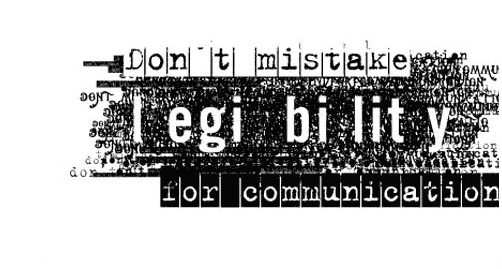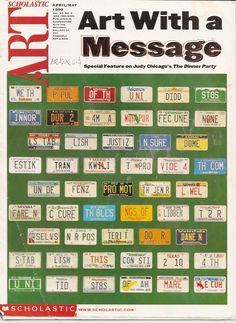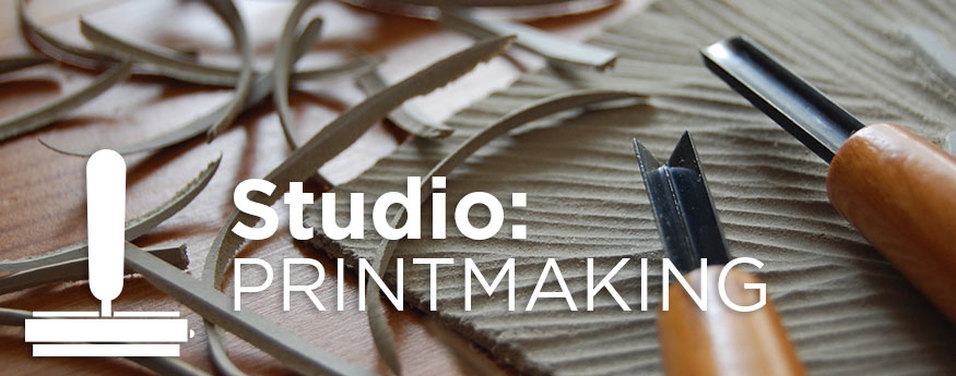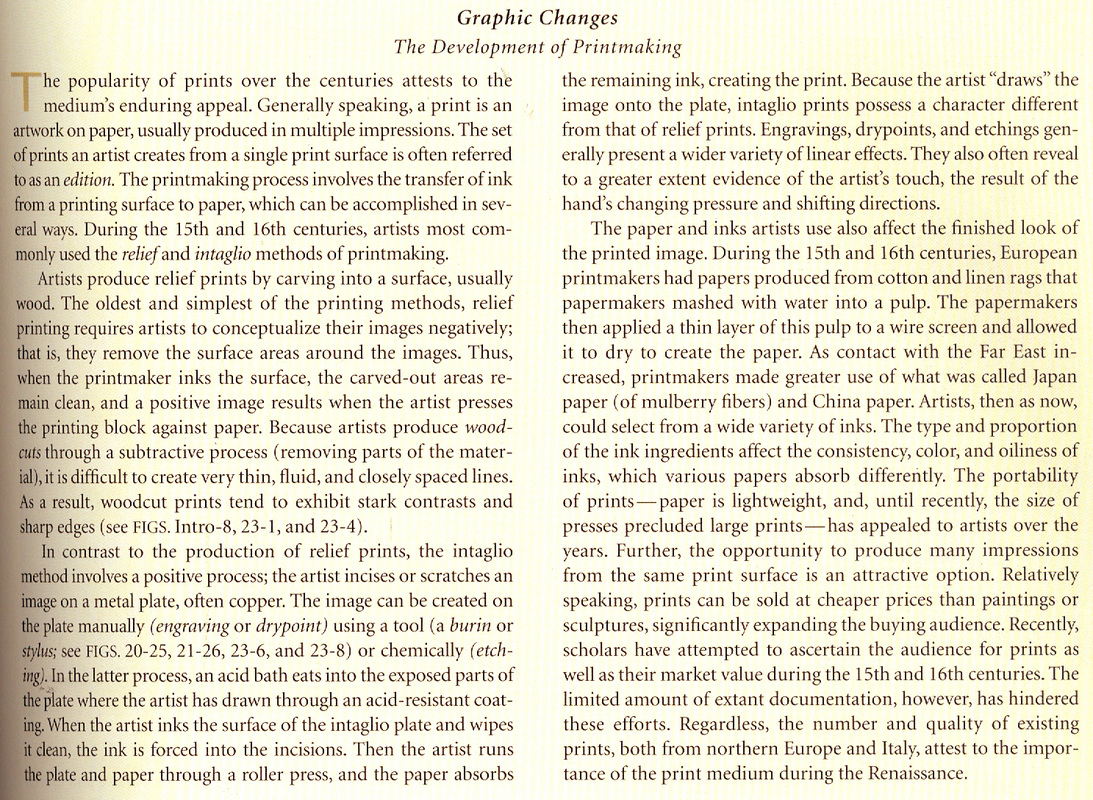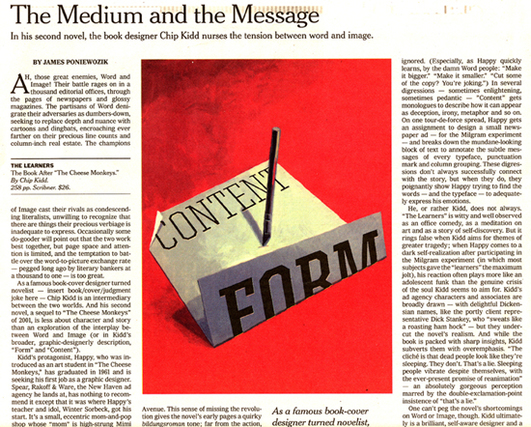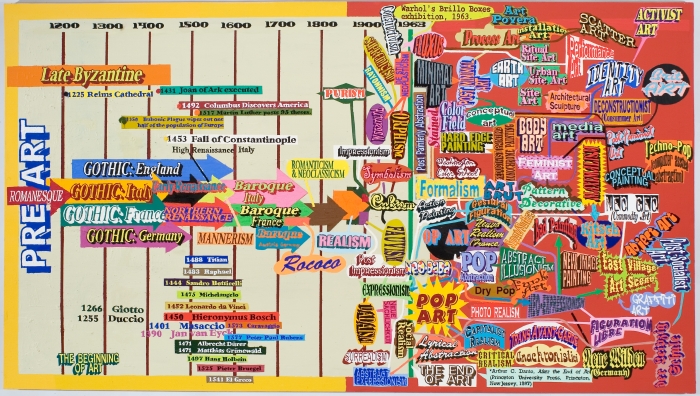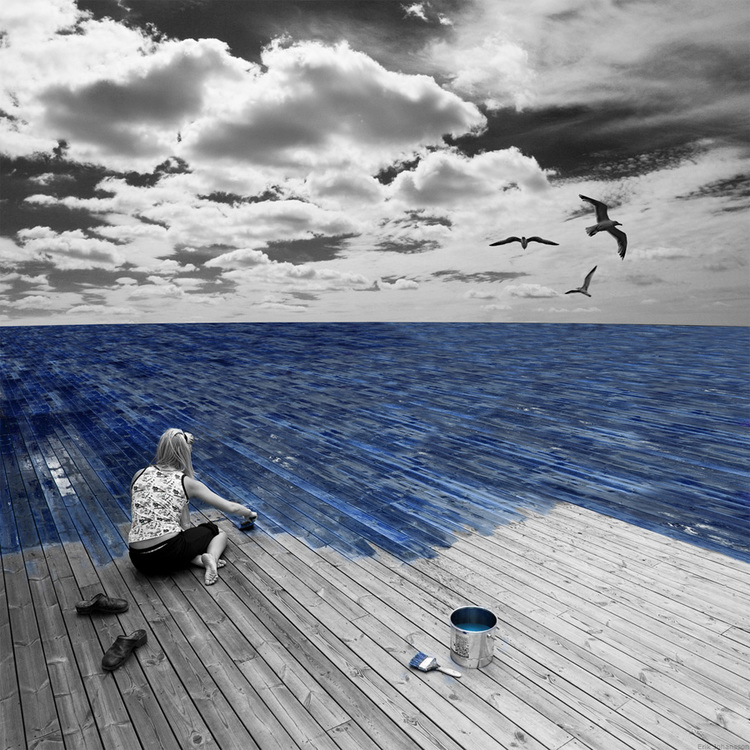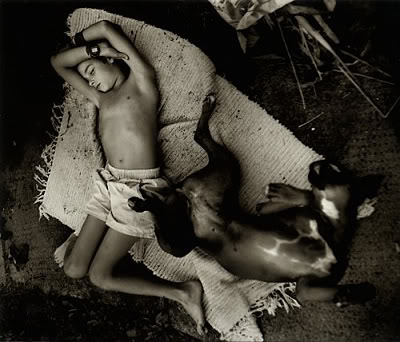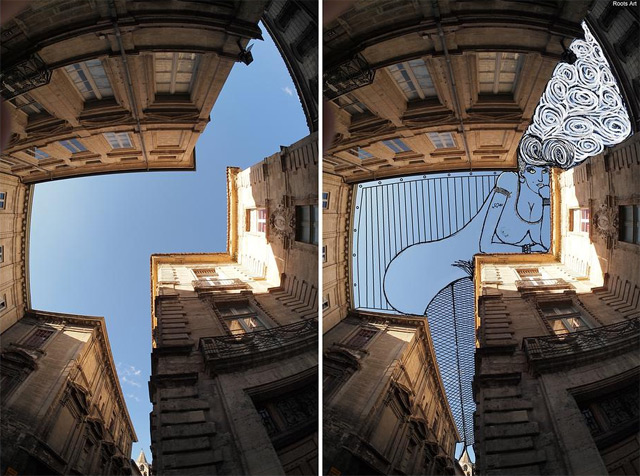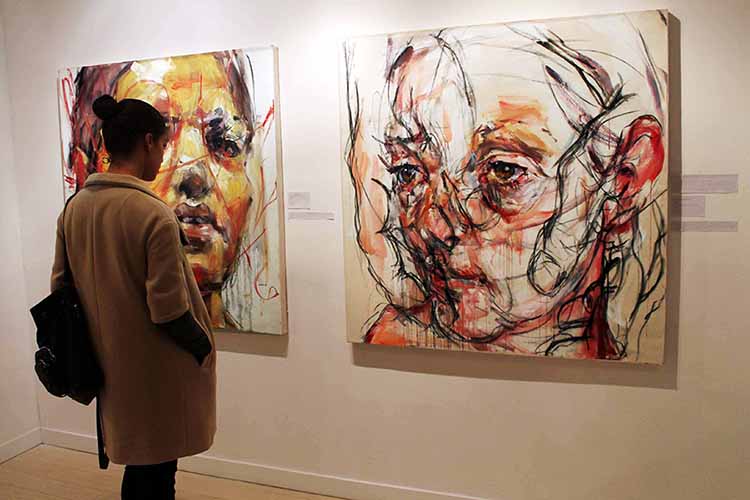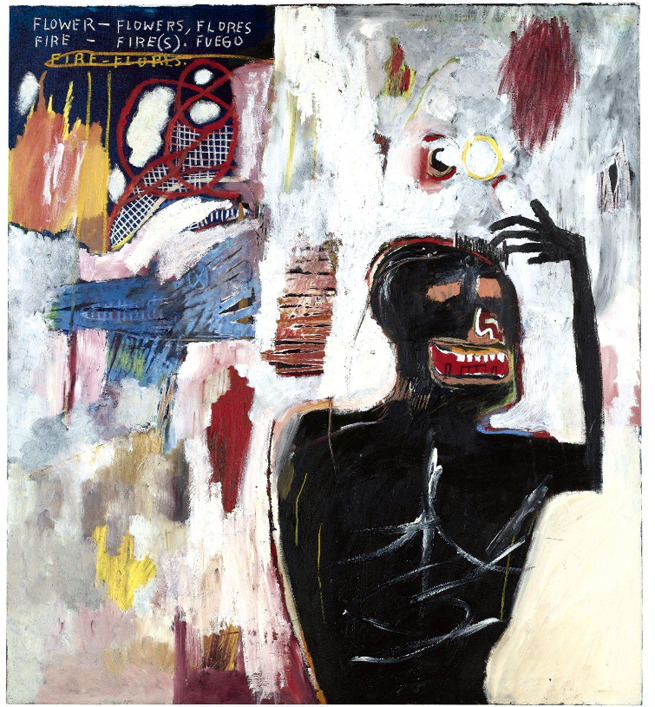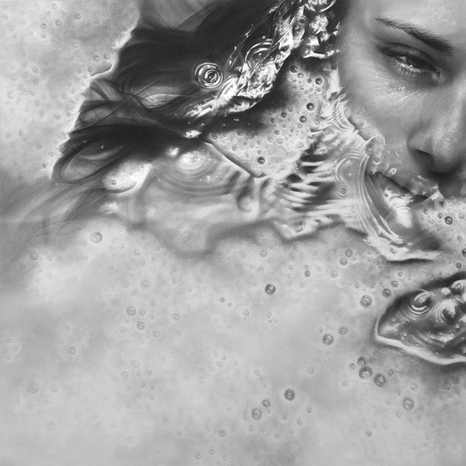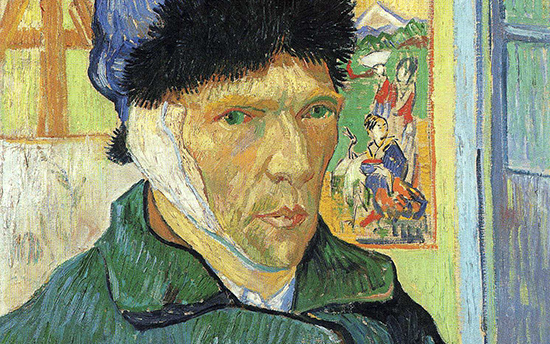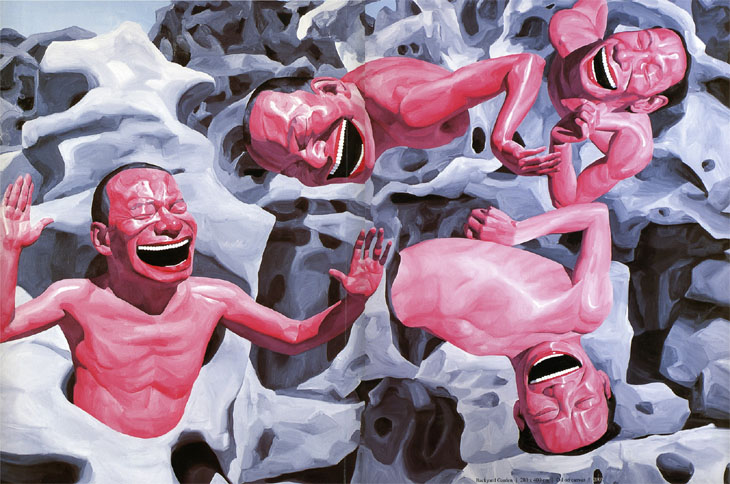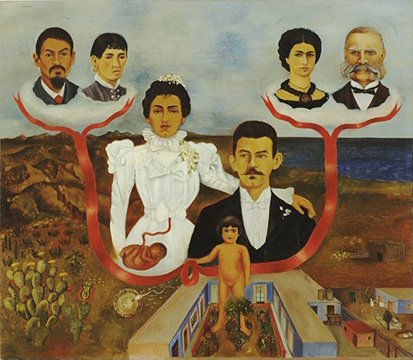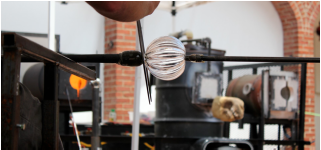FOURTH NINE WEEKS
Week 1
|
TUE 4/12
CRITICAL JOURNAL INVESTIGATIONS: (Include notes and sketches in response to this artist's work) - 1+ Pages
|
|
|
THU 4/13
CONCEPTUAL JOURNAL INVESTIGATIONS (2 Personal Lists) Sagmeister's List of "Things I have learned in my life so far"
Your Personal List #1: 16-20 things you have learned in your life so far) + sketches 1 JOURNAL page |
Sagmesiter's List of "7 Rules for life and design happiness"
Your Personal List #2: 7-10 rules for life and design happiness) + sketches 1 JOURNAL page |
Week 2
|
MON 4/18 - Continue Artist Research
CRITICAL JOURNAL INVESTIGATIONS: Include notes, direct quotes, & sketches in response to these artists' works/philosophies) - 1+ pages |
CONTEXTUAL JOURNAL INVESTIGATIONS: Revisit your list...Choose 1 of your own philosophies and dedicate 2+ pages to explain & plan visuals
WED 4/20
CONCEPTUAL JOURNAL INVESTIGATIONS: Interpret another classmate's message
Task 1: Leave your sketchbooks in your cubbies, and go get a clean sheet of white printer paper. On the top, write your name and your message. Without looking at your journal, you should rewrite the statement that you chose from the previous class, or a new statement if you have since changed your mind. Pass the paper to the front of the classroom when you are finished. They will be randomly redistributed (please be sure you do not have your own).
Task 2: To complete your journal assignment for today, you must take this other person’s statement and answer the exact same questions you answered about your own statement. These can be found above. You can also access the previous videos we watched, or watch the additional ones linked here (please use your headphones) for more inspiration. Please be sure your devices are not a distraction! You should spend the entire class responding to the other artist’s message. You must balance both text AND visuals!! Write your name at the bottom of the page. Return it to the artist by the end of the day, which you should then put your classmate's journal entry in your own journals. We will review these on Friday.
- How have you discovered this in your life? Be specific. Take yourself back to individual moments when this statement was extremely relevant. Elaborate on the details surrounding these circumstances.
- Take the most meaningful words from your philosophy and start connecting symbols and visuals that reveal aspects from your personal stories. Try rewriting these words in a way that integrates them with these symbols you chose. Work through the most obvious solutions and then get to the more creative and thought-provoking.
WED 4/20
CONCEPTUAL JOURNAL INVESTIGATIONS: Interpret another classmate's message
Task 1: Leave your sketchbooks in your cubbies, and go get a clean sheet of white printer paper. On the top, write your name and your message. Without looking at your journal, you should rewrite the statement that you chose from the previous class, or a new statement if you have since changed your mind. Pass the paper to the front of the classroom when you are finished. They will be randomly redistributed (please be sure you do not have your own).
Task 2: To complete your journal assignment for today, you must take this other person’s statement and answer the exact same questions you answered about your own statement. These can be found above. You can also access the previous videos we watched, or watch the additional ones linked here (please use your headphones) for more inspiration. Please be sure your devices are not a distraction! You should spend the entire class responding to the other artist’s message. You must balance both text AND visuals!! Write your name at the bottom of the page. Return it to the artist by the end of the day, which you should then put your classmate's journal entry in your own journals. We will review these on Friday.
Week 3
|
TUE 4/26
COMPARATIVE JOURNAL INVESTIGATIONS: Choose 2 or more artists to compare, citing 2 or more Scholastic Arts Magazines. Add 1 or more hyperlinks visited for research supporting this investigation. Include 1 or more artist quotes. Create 2 new Google Slides on your Process Portfolio with this information. Include headings and balance both text and visuals!! Some artists dealing with MESSAGES in their work include: Joshua Abelow Chila Kumari Burman Judy Chicago Jenny Holzer Barbara Kruger Robert Indiana Kerry James Marshall Annette Messager Keith Piper Ed Ruscha Ai Weiwei |
THU 4/28
CONCEPTUAL JOURNAL INVESTIGATIONS: Final Project Planning On Location! This is a site-specific installation. You must consider how your project can transform that space and how your message will impact a particular viewing audience.
CONCEPTUAL JOURNAL INVESTIGATIONS: Final Project Planning On Location! This is a site-specific installation. You must consider how your project can transform that space and how your message will impact a particular viewing audience.
Week 4 - 6
Continue working on CON~Text project
Week 7
TUE 5/24 - Complete CON~Text Project & begin hanging
THU 5/26 - Finish hanging CON~Text Project
Complete 1 Final Portfolio Slide - Graded by Tuesday 6/7 @ 8:30am
THU 5/26 - Finish hanging CON~Text Project
Complete 1 Final Portfolio Slide - Graded by Tuesday 6/7 @ 8:30am
- Include one quality image of your work hanging on location
- Add title, size, media, date, and exhibition text (500 characters w/spaces max)
- Include one quality image of your planning sketch
- Add text to explain your process of completing this project (refer to your notes on the back of the planning sketch)
Week 8
TUE 5/31 - Final Critique
THU 6/2 - Final Exam Information - Cubby/Art Room Clean Out
THU 6/2 - Final Exam Information - Cubby/Art Room Clean Out
Week 9
MON 6/6 - Graduation Practive
WED 6/8 - Begin Final Exam
WED 6/8 - Begin Final Exam
FINAL EXAM - FRIDAY JUNE 10
GRADUATION 6/18!!!!!!!!!!!!!!!!!!! Congratulations Seniors :)
THIRD NINE WEEKS
Week 1
MON 2/8 - Final Portfolio Slides Due
HOMEWORK: (DUE WEDNESDAY)
WED 2/9 - Review Printmaking Assignment Details and begin experiments with at least 2 processes - make multiples for planning/Journal
REMEMBER: YOUR DESIGNS MUST BE REVERSED!!!
HOMEWORK: (DUE WEDNESDAY)
- Read the below information on your next printmaking challenge and come prepared to both answer and ask relevant questions.
- Review Your Final Portfolio Slides and Choose One Theme (IB Handbook p.9) to write about in your Journal that brings these pieces together. This Theme will be a starting point for planning your printmaking project. Include visuals with extensive text.
WED 2/9 - Review Printmaking Assignment Details and begin experiments with at least 2 processes - make multiples for planning/Journal
REMEMBER: YOUR DESIGNS MUST BE REVERSED!!!
FRI 2/12 - Begin printmaking experiments and setup "My Visual Translator" Planning Chart to explore themes and symbols
HOMEWORK: (DUE NEXT WEDNESDAY) In your Journal, answer the following question about your printmaking project - What is my work about and what is it's function? Select One or More Cultural Values (IB Handbook p. 17) to discuss the purpose and direction of your final piece. Include visuals with extensive text.
HOMEWORK: (DUE NEXT WEDNESDAY) In your Journal, answer the following question about your printmaking project - What is my work about and what is it's function? Select One or More Cultural Values (IB Handbook p. 17) to discuss the purpose and direction of your final piece. Include visuals with extensive text.
Week 2
WED 2/17 - Complete Printmaking Planning and meet individually to explain conceptual and material choices
HOMEWORK: Explore Printmaking Processes and Techniques in a two-page spread in your Journal. Balance visuals and text!
Consider Including the following:
Visuals:
Vocabulary Terms:artist's proof, baren (Japanese hand tool for printmaking), brayer, collagraph, composition, contour, drawing from observation, edition, engraving, incised, ink, intaglio, lithograph, monoprint, monotype, multiple, negative space, numbering, plate, Plexiglas, positive area, pressure, print, printing press, process proof, Pronto Plate, pulling a print, registration, relief, reverse image, serigraph, silkscreen, stencil, Styrofoam, surface, techniques, template, texture, transfer, woodcut
Useful Links: http://www.artshow.com/resources/printmaking.html
What is a Print? http://www.moma.org/interactives/projects/2001/whatisaprint/flash.html
Video Tutorials: Relief/ Block prints/ Woodcuts/ Screen prints/ Lithography/ Etching/Collagraph/ Intaglio/ Planographic/ Chine Colle/ Monoprints
Prinmaking Examples:
http://www.metmuseum.org/toah/hd/ukiy/hd_ukiy.htm)
http://www.vam.ac.uk/content/articles/i/indian-textiles-introduction/
http://www.bbc.co.uk/education/clips/z4mc87h
http://www.metmuseum.org/toah/hd/ukiy/hd_ukiy.htm
http://www.vam.ac.uk/content/articles/i/indian-textiles-introduction/
https://www.youtube.com/playlist?list=PLD1240D899F3875A4
http://www.moma.org/visit/calendar/exhibitions/1103
http://www.christies.com/matisse/printmaker.aspx
Indian Block prints in Rajasthan
African Block Print designs
THU 2/18 - Senior Trip, ART GUILD
FRI 2/19 - HOMEWORK: Complete one or more Journal pages, which involve the Contextual Investigations below
What are the qualities of a fine-art print?
How did the invention of the printing press affect communication?
What are various ways in which printmaking affects society?
How did changes in technology affect the art print?
How did twentieth-century artists use printmaking differently than their predecessors?
How do contemporary artists use printmaking differently than their predecessors?
How do contemporary artists use print today?
How do art printmaking and mass media affect each other?
HOMEWORK: Explore Printmaking Processes and Techniques in a two-page spread in your Journal. Balance visuals and text!
Consider Including the following:
Visuals:
- Paste in actual print experiments, both relief and intaglio examples.
- Take photos of your printing plates and tools used and paste these into your journal.
- Define the methods of printmaking, key concepts, tools and safety.
- Explain what you discovered in your experiments including what you learned about the process from creating the plate to applying the ink and transferring it to another surface.
- Explain how you took risks, found merit in mistakes and errors, and learned through failure. It is important to highlight not only what worked, but what didn't work.
Vocabulary Terms:artist's proof, baren (Japanese hand tool for printmaking), brayer, collagraph, composition, contour, drawing from observation, edition, engraving, incised, ink, intaglio, lithograph, monoprint, monotype, multiple, negative space, numbering, plate, Plexiglas, positive area, pressure, print, printing press, process proof, Pronto Plate, pulling a print, registration, relief, reverse image, serigraph, silkscreen, stencil, Styrofoam, surface, techniques, template, texture, transfer, woodcut
Useful Links: http://www.artshow.com/resources/printmaking.html
What is a Print? http://www.moma.org/interactives/projects/2001/whatisaprint/flash.html
Video Tutorials: Relief/ Block prints/ Woodcuts/ Screen prints/ Lithography/ Etching/Collagraph/ Intaglio/ Planographic/ Chine Colle/ Monoprints
Prinmaking Examples:
http://www.metmuseum.org/toah/hd/ukiy/hd_ukiy.htm)
http://www.vam.ac.uk/content/articles/i/indian-textiles-introduction/
http://www.bbc.co.uk/education/clips/z4mc87h
http://www.metmuseum.org/toah/hd/ukiy/hd_ukiy.htm
http://www.vam.ac.uk/content/articles/i/indian-textiles-introduction/
https://www.youtube.com/playlist?list=PLD1240D899F3875A4
http://www.moma.org/visit/calendar/exhibitions/1103
http://www.christies.com/matisse/printmaker.aspx
Indian Block prints in Rajasthan
African Block Print designs
THU 2/18 - Senior Trip, ART GUILD
FRI 2/19 - HOMEWORK: Complete one or more Journal pages, which involve the Contextual Investigations below
What are the qualities of a fine-art print?
How did the invention of the printing press affect communication?
What are various ways in which printmaking affects society?
How did changes in technology affect the art print?
How did twentieth-century artists use printmaking differently than their predecessors?
How do contemporary artists use printmaking differently than their predecessors?
How do contemporary artists use print today?
How do art printmaking and mass media affect each other?
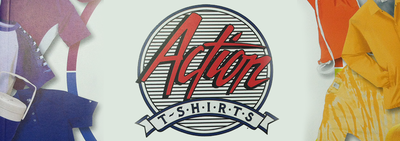
SATURDAY 2/20 @ 10am - 1pm
STUDIO VISIT!!!!
Eric Helm @ Action T-Shirts
2926 W. Marshall St. Richmond, VA 23230
The screen printing shop is a block from the corner of Broad St. and Boulevard, in Scotts Addition. Parking is directly across the street.
STUDIO VISIT!!!!
Eric Helm @ Action T-Shirts
2926 W. Marshall St. Richmond, VA 23230
The screen printing shop is a block from the corner of Broad St. and Boulevard, in Scotts Addition. Parking is directly across the street.
Week 3
TUE 2/23 - Complete "My Visual Translator" and meet individually to discuss CONTENT and FORM for final printmaking project
THU 2/25 - Begin working on final printmaking plate design
THU 2/25 - Begin working on final printmaking plate design
Week 4
MON 2/29 - Form Follows Function At-Home Assignment - Due THURSDAY MARCH 17th along with your Printmaking Project (after school we are hanging your exhibit at the Hanover Arts and Activities Center!! - Reception March 19th 3-5pm)
WED 3/2 - Continue working on Printmaking Project In-Class, Journals Due Friday
THU 3/3 - Vans Custom Culture Contest Designs Due!!
FRI 3/4 - JOURNALS DUE @ 8:30 AM!!! - Prepare Midway Critique Slides
WED 3/2 - Continue working on Printmaking Project In-Class, Journals Due Friday
THU 3/3 - Vans Custom Culture Contest Designs Due!!
FRI 3/4 - JOURNALS DUE @ 8:30 AM!!! - Prepare Midway Critique Slides
Week 5
TUE 3/8 - Continue working on Printmaking Project In-Class
Form Follows Function Project Proposal Due
THU 3/10 - Continue working on Printmaking Project In-Class
Make progress on Form Follows Function - CHECKPOINT MONDAY! - bring in work or progress photos - %50 completion expected
Form Follows Function Project Proposal Due
THU 3/10 - Continue working on Printmaking Project In-Class
Make progress on Form Follows Function - CHECKPOINT MONDAY! - bring in work or progress photos - %50 completion expected
Week 6
MON 3/14 - Finalize Printmaking Project - Share progress on Form Follows Function
ALL FINAL EXHIBIT PIECES SHOULD BE COMPLETED AND READY TO BE PHOTOGRAPHED AT THE END OF CLASS ON WEDNESDAY 3/16
WED 3/16 - PRINTMAKING PROJECT AND FORM FOLLOWS FUNCTION DUE TODAY
Finalize Exhibition Slides - Required for printing exhibition text and labels! (Must be saved in your Google Drive by 12am)
THU 3/17 - Hanging the Hanover IB Art Exhibit at the Hanover Arts and Activities Center after school (this is mandatory!!)
FRI 3/18 - Finalize Process Portfolio Slides (Must be saved in your Google Drive by 12am)
Begin Writing your Curatorial Rationale - FIRST DRAFT DUE TUESDAY
SAT 3/19 - Hanover IB Art Reception - Please plan to attend and invite your families/friends!
ALL FINAL EXHIBIT PIECES SHOULD BE COMPLETED AND READY TO BE PHOTOGRAPHED AT THE END OF CLASS ON WEDNESDAY 3/16
WED 3/16 - PRINTMAKING PROJECT AND FORM FOLLOWS FUNCTION DUE TODAY
Finalize Exhibition Slides - Required for printing exhibition text and labels! (Must be saved in your Google Drive by 12am)
THU 3/17 - Hanging the Hanover IB Art Exhibit at the Hanover Arts and Activities Center after school (this is mandatory!!)
FRI 3/18 - Finalize Process Portfolio Slides (Must be saved in your Google Drive by 12am)
Begin Writing your Curatorial Rationale - FIRST DRAFT DUE TUESDAY
SAT 3/19 - Hanover IB Art Reception - Please plan to attend and invite your families/friends!
Week 7
MON 3/21
Taking down work at the Hanover Arts and Activities Center after school (this is mandatory!!)
TUE 3/22 - First Draft of Curatorial Rationale Due @ 8:30am
Edit Comparative Study Slides
THU 3/24 - Finalize Comparative Study Slides (Must be saved in your Google Drive by 12am)
Taking down work at the Hanover Arts and Activities Center after school (this is mandatory!!)
TUE 3/22 - First Draft of Curatorial Rationale Due @ 8:30am
Edit Comparative Study Slides
THU 3/24 - Finalize Comparative Study Slides (Must be saved in your Google Drive by 12am)
SPRING BREAK!!!!!!!!!!!!!!!!!!!!!!!!!!!!!!!!!!!!!!!!!!!!!!!!!!!!!!!!!!!!!!!!!!!!!!!!!!!!!!!!!!!!!!!!!!!!!!!!!!!!!!!!!!!!!!!!!
Making Multiples
One of the advantages of printmaking is the possibility of creating multiples. You can try out different approaches, different surfaces, hand-coloring, collage and working back into the print. There is less of a sense of "preciousness" and this helps us to be more experimental. However, a successful print begins with the integrity of the initial drawing. Choosing a drawing subject with a certain visual complexity that can make you work more interesting. Your design must fit an overall concept, which should be driven by what you have or have not yet explored in your current portfolio. We will begin by exploring your options for printmaking, then we will dive in to the purpose and overall direction for this studio piece.
Final Print Series
We will ultimately be pulling at least three printed versions of a single plate together into your final piece. These can be made on a single surface or multiple surfaces brought together for the final arrangement. Each print should be unique, but they must work together as a whole, and not just as three different variations of the exact same print (this is the basic level of printmaking, and we are moving beyond that). The printed design does not have to be dominant; it can take up a very small portion of the overall layout, it can be subdued in the background or around the edge (like a pattern or border). The printed design can change orientation, be cropped differently each time, or overlap. Think about how you can create a thoughtful progression from one design to the next. For instance, you could progressively work the design from minimal to more complex, either on the printed plate, or by adding outside materials. Work to your strengths in combining other media. The print itself can be just a single layer of a more complex drawing, painting, collage, etc. You can also choose to make multiple printing plates for a complete series. The printed design will act as an element of repetition, but you should aim to include as much variation with the work as well. This is why we are avoiding three identical prints with different colors - this is not pushing the potential of the medium. You job is to push it further!
Printmaking Methods
You may choose any mode of printmaking for this assignment, and I will be providing you with any resources and assistance for each approach. I strongly recommend that you work closely with your classmates that are attempting the same method. Your choice does not have to be based on experience, but use your current knowledge to your advantage. The process you choose should support you initial design and fit the overall visual affect you desire to achieve. Other Printmaking Options: Pronto Plate (Laser Jet Print, Ink Pen, or Sharpie), Trace Monotype, Stamping, Frottage (Rubbings), Marbling, Photo Transfers (Iron-On, Purell, Modge Podge)
One of the advantages of printmaking is the possibility of creating multiples. You can try out different approaches, different surfaces, hand-coloring, collage and working back into the print. There is less of a sense of "preciousness" and this helps us to be more experimental. However, a successful print begins with the integrity of the initial drawing. Choosing a drawing subject with a certain visual complexity that can make you work more interesting. Your design must fit an overall concept, which should be driven by what you have or have not yet explored in your current portfolio. We will begin by exploring your options for printmaking, then we will dive in to the purpose and overall direction for this studio piece.
Final Print Series
We will ultimately be pulling at least three printed versions of a single plate together into your final piece. These can be made on a single surface or multiple surfaces brought together for the final arrangement. Each print should be unique, but they must work together as a whole, and not just as three different variations of the exact same print (this is the basic level of printmaking, and we are moving beyond that). The printed design does not have to be dominant; it can take up a very small portion of the overall layout, it can be subdued in the background or around the edge (like a pattern or border). The printed design can change orientation, be cropped differently each time, or overlap. Think about how you can create a thoughtful progression from one design to the next. For instance, you could progressively work the design from minimal to more complex, either on the printed plate, or by adding outside materials. Work to your strengths in combining other media. The print itself can be just a single layer of a more complex drawing, painting, collage, etc. You can also choose to make multiple printing plates for a complete series. The printed design will act as an element of repetition, but you should aim to include as much variation with the work as well. This is why we are avoiding three identical prints with different colors - this is not pushing the potential of the medium. You job is to push it further!
Printmaking Methods
You may choose any mode of printmaking for this assignment, and I will be providing you with any resources and assistance for each approach. I strongly recommend that you work closely with your classmates that are attempting the same method. Your choice does not have to be based on experience, but use your current knowledge to your advantage. The process you choose should support you initial design and fit the overall visual affect you desire to achieve. Other Printmaking Options: Pronto Plate (Laser Jet Print, Ink Pen, or Sharpie), Trace Monotype, Stamping, Frottage (Rubbings), Marbling, Photo Transfers (Iron-On, Purell, Modge Podge)
STEPS FOR PREPARING FINAL PORTFOLIO SLIDES
At this point you should have 2 completed final portfolio slides from the first nine weeks. We will be adding 3 more slides to that document today. These represent 5 studio pieces that you will definitely have in your one-woman show.
We will be examining these 5 slides to determine an appropriate direction for your final two projects.
This nine weeks you will have the opportunity to add 2 additional pieces (1 In-Class and 1 At-Home). Your final exhibition will have 7 pieces total. The venue for the IB show is the Hanover Arts and Activity Center, 500 South Center Street in Ashland. The work will be set up on Thursday, March 17th. It will be on display until we take it down on Monday, March 21st. This means we have less than SIX WEEKS to prepare!!! Please remember to keep all studio pieces here to be matted and stored for the exhibit.
NOTE: HL ONLY - Bring in 2-4 pieces from last year to contribute to your final exhibition. These slides should also be added ASAP.
Slide 1 & 2 - First Nine Weeks Projects
Slide 3 - Comparative Study - Image (from Drive) + Title + Month/Year + Media (ALL materials used) + Dimensions (CM. = IN. x 2.54)
+ Exhibition Text: 500 characters with spaces (4-6 sentences)
Slide 4 - Photo Book OR Summer Project -Image (from Drive) + Title + Month/Year + Media (ALL materials used) + Dimensions (Centimeters = IN. x 2.54) + Exhibition Text: 500 characters with spaces (4-6 sentences)
Slide 3 - Summer Project - Image (from Drive) + Title + Month/Year + Media (ALL materials used) + Dimensions (Centimeters = IN. x 2.54)
+ Exhibition Text: 500 characters with spaces (4-6 sentences)
Writing exhibition text: For each artwork you submit, it should be supported by exhibition text that outlines the original intentions of the work (500 characters maximum—including spaces—per artwork). The text should explain your approach to the project, and should reference any sources that have influenced the individual piece. When completed, this information will be printed out and included in your exhibition to help your audience appreciate your work more fully. Mounting printed exhibition text on foam core board will give your exhibition a professional fee!
At this point you should have 2 completed final portfolio slides from the first nine weeks. We will be adding 3 more slides to that document today. These represent 5 studio pieces that you will definitely have in your one-woman show.
We will be examining these 5 slides to determine an appropriate direction for your final two projects.
This nine weeks you will have the opportunity to add 2 additional pieces (1 In-Class and 1 At-Home). Your final exhibition will have 7 pieces total. The venue for the IB show is the Hanover Arts and Activity Center, 500 South Center Street in Ashland. The work will be set up on Thursday, March 17th. It will be on display until we take it down on Monday, March 21st. This means we have less than SIX WEEKS to prepare!!! Please remember to keep all studio pieces here to be matted and stored for the exhibit.
NOTE: HL ONLY - Bring in 2-4 pieces from last year to contribute to your final exhibition. These slides should also be added ASAP.
Slide 1 & 2 - First Nine Weeks Projects
Slide 3 - Comparative Study - Image (from Drive) + Title + Month/Year + Media (ALL materials used) + Dimensions (CM. = IN. x 2.54)
+ Exhibition Text: 500 characters with spaces (4-6 sentences)
Slide 4 - Photo Book OR Summer Project -Image (from Drive) + Title + Month/Year + Media (ALL materials used) + Dimensions (Centimeters = IN. x 2.54) + Exhibition Text: 500 characters with spaces (4-6 sentences)
Slide 3 - Summer Project - Image (from Drive) + Title + Month/Year + Media (ALL materials used) + Dimensions (Centimeters = IN. x 2.54)
+ Exhibition Text: 500 characters with spaces (4-6 sentences)
Writing exhibition text: For each artwork you submit, it should be supported by exhibition text that outlines the original intentions of the work (500 characters maximum—including spaces—per artwork). The text should explain your approach to the project, and should reference any sources that have influenced the individual piece. When completed, this information will be printed out and included in your exhibition to help your audience appreciate your work more fully. Mounting printed exhibition text on foam core board will give your exhibition a professional fee!
SECOND NINE WEEKS
Week 1
TUE 11/9
KEY TERMS
KEY TERMS
- Identity: is about personal, social, and cultural interactions. All people are complex, with multiple, and overlapping identities.
- Zine: a noncommercial often homemade or online publication usually devoted to specialized and often unconventional subject matter
- Paul Graham: born 1956 in the UK studied microbiology and received his BS from Bristol University, UK in 1978. Graham is highly credited in fostering a new school of British photographers that embraced color photography with his early bodies of work A1-The Great North Road documenting the first major road running through the entirety of England as well as unemployment offices in Beyond Caring. He had a firm hold on the observable world photographing everyday people, places, and events that challenge the viewer to question human existence.
JOURNAL ASSIGNMENT:
- What makes up an identity? What aspects of your identity have you conveyed thus far in your previous work?
- In your journals list 100 things that could define your identity (ex/ humor, drawing, parents, religion, fashion).
- Try by starting with broad topics and slowly go into specifics
- You will be creating Photo zines that play with the placement of an image that includes 15-20 images, and incorporates text throughout the zine.
- Looking at the list you just made, what key elements do you feel most connected to? Choose at least 5.
- Brainstorm how to document those 5 elements from your list. Ex/ if an element was music, some of my ideas would consist of a concert, music video, playlist, instrument, notes, band tee shirts
- In your journals, draw out 15-20 boxes as a visual template for your final zine.
- Begin documenting images from your Iphone that would correlate to the 5 items selected from your list.
- Try to collect images throughout the day, focusing on the banal, ordinary, plain. How can you enhance these?
- Using your Iphones, begin taking pictures of elements that could define your identity. SUBMIT VIA GOOGLE DRIVE!!!
THU 11/11
Look at various interpretations of photo books
- Sophie Calle : a French artist who works with photographs and performances, placing herself in situations almost as if she and the people she encounters were fictional. She also imposes elements of her own life onto public places creating a personal narrative where she is both author and character. She has been called a detective and a voyeur and her pieces involve serious investigations as well as natural curiosity. “Take Care of Yourself”: http://www.violetteeditions.com/books/other-publications/prenez-soin-de-vous.php
- Colette Fu: Fu’s initial pop-up work was more abstract, with underlying themes of consumerism and the body in a modern world of excess. But since 2008 her personal focus has been on work about the lives of the minorities of China, not far removed from her previous work. Colette’s recent series, entitled We Are Tiger Dragon People represents an interactive 3D glimpse into China's stunning human diversity of 25 officially recognized ethnic minority groups that reside in Yunnan Province. Accompanying text introduces traditions, folklore and other culturally unique examples of their ways of living.Fu discovered that her own personal anxiety was part lack of respecting and relating to any cultural identity. As her artwork has evolved, she uses it to promote respect, love, and the beauty of diversity and recently has extended her work to other minority communities. She believes recognition and celebration of diversity in others and ourselves leads us to stronger identity and involvement with the world. http://www.colettefu.com/
- Indie Photo Book: contains self-published or independent photo books, books that use photography as the main content. Photo books are sometimes considered artists’ books, but photo books have also been considered their own genre .http://www.indiephotobooklibrary.org/
JOURNAL ASSIGNMENT:
- How do your images exemplify your identity? Your thoughts? Your stances? What feeling are you generally exerting with these combination of images?
- With the collection of images you have in front of you, what terms come to mind? If we analyze our collection, what can we decipher about ourselves? Ex/ I really enjoy taking pictures of the formal qualities of nature, I really enjoy the color pink, I enjoy taking portraits of my father
HOMEWORK
- Bring in objects to scan!
- Continue adding to your archived images - SUBMIT VIA GOOGLE DRIVE
- By next class students, have 2 artists names, bio, examples of work, style of photo book, culture.
Week 2
MON 11/16
Explore how to create a storyline using Visual Juxtaposition to marry text & image
KEY TERMS:
QUESTIONS TO CONSIDER:
How can we play with the notion of visual juxtaposition using the new images we took?
how can these images convey a certain opinion, story, feeling?
how can we create a visual beginning middle and end within our photobook?
color schemes? visual communication? formal elements? subject matter? text?
ASSIGNMENT: Experiment with layouts - Sign Up for Shutterfly
WED 11/18- Exploring how to make our FINAL photo books in InDesign
KEY TERMS:
ASSIGNMENT: You will begin exploring composition, visual narrative, and juxtaposition using InDesign. Remember, you must have 15-20 images and text. You will be working with 12 pages (24 spreads).
Follow the guides below if you need help:
Explore how to create a storyline using Visual Juxtaposition to marry text & image
KEY TERMS:
- Photo Book: A photo-book or photobook is a book in which photographs make a significant contribution to the overall content.
- White Balance: takes into account the "color temperature" of a light source, which refers to the relative warmth or coolness of white light.
- Kelvin Scale: It is simply a unit of measurement for temperature and in photography we most often use it to measure the color temperature of light sources
- Visual juxtaposition: is inquiry through contrast, facilitated by side-by-side positioning of two images, or images and text
QUESTIONS TO CONSIDER:
How can we play with the notion of visual juxtaposition using the new images we took?
how can these images convey a certain opinion, story, feeling?
how can we create a visual beginning middle and end within our photobook?
color schemes? visual communication? formal elements? subject matter? text?
ASSIGNMENT: Experiment with layouts - Sign Up for Shutterfly
- Go to My Pictures
- Download 10 images from google drive, if not use a usb > Save to desktop
- Click Upload > Choose Files > Desktop > Select
- Create New Folder > Choose Title > Upload > Close Window
- Create Photo Book
- Click on custom path
- 8x11> portfolio
- Either all black or all white (simply white or modern black) > Select this photo book > Start
- Add Photos > Shutterfly > Select Album > Select All > Add to Project
- Place Photos Myself
- Under the “Pages” tab click on "Customize Page”
- This will allow you to drag and drop, resize, order, text, frame, etc.
WED 11/18- Exploring how to make our FINAL photo books in InDesign
KEY TERMS:
- InDesign: its specific purpose is for laying out printed materials; that’s what it is designed to do. This could be brochures, newsletters, ads, business cards or books. Virtually anything that is made up of a combination of blocks of text, photos or other artwork.
- Master Page: A master is like a background that you can quickly apply to many pages. Objects on a master appear on all pages with that master applied. Master items that appear on document pages are surrounded by a dotted border. Changes you make to a master are automatically applied to associated pages.
ASSIGNMENT: You will begin exploring composition, visual narrative, and juxtaposition using InDesign. Remember, you must have 15-20 images and text. You will be working with 12 pages (24 spreads).
Follow the guides below if you need help:
Homework: Knowing the foundation of how to go about creating your book, start thinking about how to incorporate text.
You should be continuing to shoot, bringing in objects to scan in, drawing, renting cameras, essentially developing material for your book. THE MORE YOU HAVE THE EASIER IT WILL BE TO COMPOSE YOUR BOOK
- Questions to Consider: What images do you want to highlight? What message do you want to get across? Is your text going to be labels of artwork, poems, essays, journal entry, rambling, or all of the above?
You should be continuing to shoot, bringing in objects to scan in, drawing, renting cameras, essentially developing material for your book. THE MORE YOU HAVE THE EASIER IT WILL BE TO COMPOSE YOUR BOOK
ARTIST EXAMPLES:
Frans Lanting "Okavango"
Nathan Pierce "Midwest Dirt"
Andrew Bush "Drive"
Robert Capa "Capa In Color"
Paco Garcia "Un Buen Dia"
Matthew Reinhart "Pop-Ups"
Richard Mosse: Vimeo - The Impossible Picture, Portfolio Site
Steve McCurry - Galleries
JenDavis "Eleven Years"
Lauren Marsolier "Transition"
Sophie Calle "Prenez Soin de Vous"
Tammy Mercure "The Quarter"
Rob O'Neil "Delaware & Hudson Railroad"
Josh Terris "Full Bore"
Laura Callaghan Illustrations
Volker Heinze "Ahnung"
Laszlo Moholy-Nagy "Malerei Fotographie Film"
Joseph Cornell "Manual of Marvels"
FRI 11/20 - Continue Working on Spreads - Online Resource: https://thephotobook.wordpress.com/
Frans Lanting "Okavango"
Nathan Pierce "Midwest Dirt"
Andrew Bush "Drive"
Robert Capa "Capa In Color"
Paco Garcia "Un Buen Dia"
Matthew Reinhart "Pop-Ups"
Richard Mosse: Vimeo - The Impossible Picture, Portfolio Site
Steve McCurry - Galleries
JenDavis "Eleven Years"
Lauren Marsolier "Transition"
Sophie Calle "Prenez Soin de Vous"
Tammy Mercure "The Quarter"
Rob O'Neil "Delaware & Hudson Railroad"
Josh Terris "Full Bore"
Laura Callaghan Illustrations
Volker Heinze "Ahnung"
Laszlo Moholy-Nagy "Malerei Fotographie Film"
Joseph Cornell "Manual of Marvels"
FRI 11/20 - Continue Working on Spreads - Online Resource: https://thephotobook.wordpress.com/
Week 3
TUE 11/24 - InDesign / Bookbinding
Resources:
Resources:
- Coptic binding: the first true codices, are characterized by one or more sections of parchment, papyrus, or paper sewn through their folds, and (if more than one section) attached to each other with chain stitch linings across the spine, rather than to the thongs or cords running across the spine that characterize European bindings from the 8th century onwards. https://www.youtube.com/watch?v=S2FRKbQI2kY
- Single Sheet Binding using Coptic Binding: https://www.youtube.com/watch?v=04vt8YfT7XM
- 3-hole Pamphlet stitch: The simplest method of binding a single signature codex, or a book bound on one edge, is with a pamphlet stitch. In this technique, the cover and signature are sewn at once. There are three basic variations of the pamphlet stitch: the three-hole (station), the four-hole and the five-hole. http://www.designsponge.com/2013/03/bookbinding-101-five-hole-pamphlet-stitch.html
- Japanese Bookbinding: uses nested signatures rather than stacked signatures to create a single backbone. As the name implies, the threads are sewn through the side of signatures close to the spine. This technique produces an incredibly strong book block. https://www.youtube.com/watch?v=j-r6c_trSxY
- Perfect Binding: No sewn binding method. Good for single sheet binding https://www.youtube.com/watch?v=GFbgW0r7uXw
- Saddle Stitch: https://www.youtube.com/watch?v=aWHkY5jOoqM
Week 4
TUE 12/1 - Library - InDesign
THU 12/3 - Group 1 Printing Photo Books
ART GUILD
FRI 12/4 -8 JOURNAL PAGES DUE @ 8:30am
THU 12/3 - Group 1 Printing Photo Books
ART GUILD
FRI 12/4 -8 JOURNAL PAGES DUE @ 8:30am
Week 5
MON 12/7 - Group 2 Print Photo Books, Bind Books, Scan Journal Pages
Learn how to package your Photo Book for the NY Art Book Fair submission process. http://nyartbookfair.com/form/
Write an Artist Statement connected to your Photo Book to promote it! (Guide to Writing an Artist Statement)
WED 12/9 - Scan Journal Pages, Build Final Critique Slides
Slides for Final Critique 1
Slide 1 – Project Intentions (5pts)
Slide 2 – Media Explorations (5pts)
Slide 3 – Artist 1 (5pts)
Slide 4 - Artist 2 (5pts)
Slide 5 - Artist Comparison (5pts)
FRI 12/11 - FINAL CRITIQUE
Learn how to package your Photo Book for the NY Art Book Fair submission process. http://nyartbookfair.com/form/
Write an Artist Statement connected to your Photo Book to promote it! (Guide to Writing an Artist Statement)
WED 12/9 - Scan Journal Pages, Build Final Critique Slides
Slides for Final Critique 1
Slide 1 – Project Intentions (5pts)
Slide 2 – Media Explorations (5pts)
Slide 3 – Artist 1 (5pts)
Slide 4 - Artist 2 (5pts)
Slide 5 - Artist Comparison (5pts)
FRI 12/11 - FINAL CRITIQUE
Week 6
TUE 12/15 - Introduction to Comparative Study
THU 12/17 - Comparative Study Planning
IB EXAM Requirements:
- 10-15 "Screens" comparing at least 3 artworks of 2 artists from different cultures
- 3-5 "Screens" reflecting on personal artworks and practices that have been influenced by any of the artists examined
CRITERIA:
A. Analysis of formal qualities
B. Interpretation of function and purpose
C. Evaluation of cultural significance
D. Making comparisons and connections
E. Presentation and subject specific language
F. (HL ONLY) Making connections to own art-making practice
Comparative Study Student A_SL
Comparative Study Student B_HL
Comparative Study Student C_HL
ONE MORE EXAMPLE
TO BEGIN PLANNING....Let's utilize Mind Mapping
IB EXAM Requirements:
- 10-15 "Screens" comparing at least 3 artworks of 2 artists from different cultures
- 3-5 "Screens" reflecting on personal artworks and practices that have been influenced by any of the artists examined
CRITERIA:
A. Analysis of formal qualities
B. Interpretation of function and purpose
C. Evaluation of cultural significance
D. Making comparisons and connections
E. Presentation and subject specific language
F. (HL ONLY) Making connections to own art-making practice
Comparative Study Student A_SL
Comparative Study Student B_HL
Comparative Study Student C_HL
ONE MORE EXAMPLE
TO BEGIN PLANNING....Let's utilize Mind Mapping
Create a mindmap to help finalize the research and studio components for the Comparative Study - Photograph for slides/journal
Week 7
MON 1/4 - Comparative Study Slides and/or Studio Project
WED 1/6 - Comparative Study Slides and/or Studio Project
THU 1/7 - ART GUILD
FRI 1/8 - Comparative Study Slides and Studio Project CHECKPOINT (25% = 4 slides + beginning stages of final studio project)
WED 1/6 - Comparative Study Slides and/or Studio Project
THU 1/7 - ART GUILD
FRI 1/8 - Comparative Study Slides and Studio Project CHECKPOINT (25% = 4 slides + beginning stages of final studio project)
Week 8
TUE 1/12 - Comparative Study Progress Checkpoint
Open up your Google Drive folder - Open the new folder titled COMPARATIVE STUDY - Inside I created a new doc titled PROGRESS FORM
You have 15 minutes to answer the first half of this form on the 2 artists - BE DIRECT AND CONCISE
Articulate your process and intent by answering the following questions about WHO, WHAT, WHEN, WHERE, WHY, and HOW.
Artist 1: WHO are you investigating, WHERE do they came from, WHEN were they working, and WHAT do they do?
WHY does their work interest you and HOW are you planning to translate that into your own work?
Artist 2: WHO are you investigating, WHERE do they came from, WHEN were they working, and WHAT do they do?
WHY does their work interest you and HOW are you planning to translate that into your own work?
You have 15 minutes to answer the second half of this form on your current progress and questions for me
NOW You as the Artist: Intent - WHAT ideas are you communicating in your studio work? Process - HOW are you using your materials to accomplish this? Progress - WHERE are you right now in this process?
(drag the following items into this new folder - Project Proposals, Comparative Study Slides, Studio Images)
NOW Me as your Teacher: WHAT struggles have you been facing? HOW do you need help moving forward? WHEN do you have time for extra help?
We will spend our remaining time opening up to question and answer
THU 1/14 - Comparative Study Slides and Studio Project Individual Meetings and Work Time
Remember, it should be very evident you are spending equal amount of time & effort on this assignment at home (6+ hours each week)
CHECKPOINT (50% = 8 slides + midway progress of final studio project)
FRI 1/15 - 8 JOURNAL PAGES DUE @ 8:30am
Open up your Google Drive folder - Open the new folder titled COMPARATIVE STUDY - Inside I created a new doc titled PROGRESS FORM
You have 15 minutes to answer the first half of this form on the 2 artists - BE DIRECT AND CONCISE
Articulate your process and intent by answering the following questions about WHO, WHAT, WHEN, WHERE, WHY, and HOW.
Artist 1: WHO are you investigating, WHERE do they came from, WHEN were they working, and WHAT do they do?
WHY does their work interest you and HOW are you planning to translate that into your own work?
Artist 2: WHO are you investigating, WHERE do they came from, WHEN were they working, and WHAT do they do?
WHY does their work interest you and HOW are you planning to translate that into your own work?
You have 15 minutes to answer the second half of this form on your current progress and questions for me
NOW You as the Artist: Intent - WHAT ideas are you communicating in your studio work? Process - HOW are you using your materials to accomplish this? Progress - WHERE are you right now in this process?
(drag the following items into this new folder - Project Proposals, Comparative Study Slides, Studio Images)
NOW Me as your Teacher: WHAT struggles have you been facing? HOW do you need help moving forward? WHEN do you have time for extra help?
We will spend our remaining time opening up to question and answer
THU 1/14 - Comparative Study Slides and Studio Project Individual Meetings and Work Time
Remember, it should be very evident you are spending equal amount of time & effort on this assignment at home (6+ hours each week)
CHECKPOINT (50% = 8 slides + midway progress of final studio project)
FRI 1/15 - 8 JOURNAL PAGES DUE @ 8:30am
Week 9
TUE 1/19 - Comparative Study Slides and/or Studio Project
THU 1/21 - Comparative Study Slides and Studio Project CHECKPOINT (75% = 12 slides + near completion of final studio project)
ART GUILD
THU 1/21 - Comparative Study Slides and Studio Project CHECKPOINT (75% = 12 slides + near completion of final studio project)
ART GUILD
MIDTERM EXAM (No Exemptions!)
MON 1/25 - Comparative Study Slides and/or Studio Project
FRI 1/29 - Comparative Study and Final Studio Project should be ready to present during the Exam Block beginning promptly @ 8:30am Every presenter will get 10 minutes to speak about their work
FRI 1/29 - Comparative Study and Final Studio Project should be ready to present during the Exam Block beginning promptly @ 8:30am Every presenter will get 10 minutes to speak about their work
FIRST NINE WEEKS
Week 1
WED 9/13 - Review Class Expectations, Write I AM POEM
HW = Get Syllabus Signed, Bring in Art Guild/NAHS dues
FRI 9/11 - Review Summer Work
Share I AM POEM
HW = Bring in THREE or more objects that correspond to your I AM POEM
Impromptu Curating Activity:
Curate comes from Latin: curare meaning "take care"; to curate is to oversee and care for a collection.
Objective: Curating, presenting and articulating intention will be an important part of the final exhibition assessment
Assignment: Choose three summer pieces that work together visually or thematically - one must be your own, two must be from two different artists - you must have more than one media represented in your exhibit - spend some time with the three pieces and list some of the similarities and differences among the works - then list the strengths and weaknesses - this will be the starting point for all of us to elaborate on during the critique - choose your space to display the work on the wall and provide a label to identify the collection
Share I AM POEM
HW = Bring in THREE or more objects that correspond to your I AM POEM
Impromptu Curating Activity:
Curate comes from Latin: curare meaning "take care"; to curate is to oversee and care for a collection.
Objective: Curating, presenting and articulating intention will be an important part of the final exhibition assessment
Assignment: Choose three summer pieces that work together visually or thematically - one must be your own, two must be from two different artists - you must have more than one media represented in your exhibit - spend some time with the three pieces and list some of the similarities and differences among the works - then list the strengths and weaknesses - this will be the starting point for all of us to elaborate on during the critique - choose your space to display the work on the wall and provide a label to identify the collection
Week 2
TUE 6/15
Finish Summer Critique
Share Personal Objects
Finish Summer Critique
Share Personal Objects
PHOTOGRAPHY MEETS DRAWING
Slides & Artists: 1-10: Aliza Razell, 11-20: Rick Dingus, 21-30: Sebastian Del Grosso, 31-40: Thomas Lamadieu
Slides & Artists: 1-10: Aliza Razell, 11-20: Rick Dingus, 21-30: Sebastian Del Grosso, 31-40: Thomas Lamadieu
THU 6/17
Fantastic Four Challenge:
Next Week we will Critique your first 4 compositions and then you can choose a studio focus to complete your final project - You must combine at least one photographic element and one drawing element - The overall concept should relate to IDENTITY
HW = Review the Themes & Artists for IDENTITY - Find your own examples of a piece that demonstrates aspects of that artist's identity - be prepared to share name and title on MON
Fantastic Four Challenge:
- Create 4 different Compositions using the same elements
- Explore at least 4 different Media (Drawing: Greyscale & Color - Photography: Photogram & Still Life), and 4 Values Max
- Divide into Learning Groups of 4 (2 photographers and 2 visual artists) to move through each studio: (45 minutes per station)
- Greyscale Drawing Studio - create still life drawings using Graphite, Charcoal OR Sharpie - remember limit 4 Values (not including background paper)
- Darkroom Studio - use objects to create the outline of shapes and textures on photo paper then draw details/patterns on top OR create a drawing on a transparency then create a Photogram to reverse the values
- Color Drawing Studio - create still life drawings using Watercolor, Colored Pencils, OR Paint - remember limit 4 values (not including background paper)
- Lighting Studio - take a still life photo of one or more objects on a white background (digital or film) then print and add drawing OR create a drawing to photograph with one or more objects
Next Week we will Critique your first 4 compositions and then you can choose a studio focus to complete your final project - You must combine at least one photographic element and one drawing element - The overall concept should relate to IDENTITY
HW = Review the Themes & Artists for IDENTITY - Find your own examples of a piece that demonstrates aspects of that artist's identity - be prepared to share name and title on MON
Week 3
MON 9/21
Turn in Artist Examples
Complete Fantastic Four Challenge with your learning groups
Review I AM Project
Book Chats
HW = Explore Theme: IDENTITY & Pick 2 Artists for 2 different Cultures to investigate in your Journals
Identity is the way we perceive and express ourselves. Factors and conditions that an individual is born with—such as ethnic heritage, sex, or one’s body—often play a role in defining one’s identity. However, many aspects of a person’s identity change throughout his or her life. People’s experiences can alter how they see themselves or are perceived by others. Conversely, their identities also influence the decisions they make: Individuals choose their friends, adopt certain fashions, and align themselves with political beliefs based on their identities. Many artists use their work to express, explore, and question ideas about identity.
Turn in Artist Examples
Complete Fantastic Four Challenge with your learning groups
Review I AM Project
Book Chats
HW = Explore Theme: IDENTITY & Pick 2 Artists for 2 different Cultures to investigate in your Journals
Identity is the way we perceive and express ourselves. Factors and conditions that an individual is born with—such as ethnic heritage, sex, or one’s body—often play a role in defining one’s identity. However, many aspects of a person’s identity change throughout his or her life. People’s experiences can alter how they see themselves or are perceived by others. Conversely, their identities also influence the decisions they make: Individuals choose their friends, adopt certain fashions, and align themselves with political beliefs based on their identities. Many artists use their work to express, explore, and question ideas about identity.
I AM PROJECT REQUIREMENTS:
THU 9/23
Discuss artworks dealing with Identity
- Select two artists from 2 separate cultures to analyze and evaluate before attempting to use their art-making methods.
- You will create two works (one In-Class and one At-Home, at least 9 x 12) that communicate the same subject/message (related to your identity). The media we will focus on for the In-Class studio project will be Photography and Drawing. Your At-Home studio project can be any media of your choice.
- The information below is meant to guide your Journal entries. Come up with your own headings for each page. Do not number your answers to each question. Each and every page must be balanced with text and visuals and include citations.
- Create a page in your Visual Art Journal that shows sketches or reproductions of the work. Answer these questions:
- When was each created?
- Who was the intended audience? Think time, place and place in society ($$).
- Explain the steps the artist used to create the work. What did they do first? Second? And so on… Cite materials used in the steps.
- How is the theme of identity expressed?
- Include a written criticism for each work – be clear, concise and use correct terminology! Write 1-2 detailed sentence(s) for each:
- Describe (who did it, what is it, when was it done, what is in the work)
- Analyze (which elements are used to create what principle)
- Interpret (emotions, meaning, message)
- Judge (is the work successful – consider the function/purpose of the art and the audience is it intended for)
- Compare and contrast the works selected :
- Compare the cultural contexts of the work, how are they shaped by their culture and time?
- Compare the formal qualities, how are they similar, how do they differ?
- Compare the content, motifs, signs, symbols…how is meaning communicated?
- Compare the material and conceptual significance, how is this related to cultural context?
- Explain how you worked through your initial media experiments to get to a more formalized plan for the project you will be completing both In-Class and At-Home
THU 9/23
Discuss artworks dealing with Identity
Complete first round of Fantastic Four Challenge Experiments
Eliminate one photography and one drawing studio (decide on darkroom or digital photography, color or greyscale drawing)
Revisit the studio of your choice - you will not stay within your same learning groups
Eliminate one photography and one drawing studio (decide on darkroom or digital photography, color or greyscale drawing)
Revisit the studio of your choice - you will not stay within your same learning groups
Week 4
MON 9/28 - Share Fantastic Four Challenge
Finalize your plan to complete your first In-Class Assignment - Eliminate one photography and one drawing studio
Revisit the studio of your choice
Reminders: Art Guild Meeting this Thursday & Journals Due next Monday
WED 9/30 -Make progress on your first In-Class Assignment (& At-Home Assignment + Journal)
(THU 10/1 - Art Guild Meeting after school)
FRI 10/2 - Continue progress on your first In-Class Assignment (& At-Home Assignment + Journal)
Finalize your plan to complete your first In-Class Assignment - Eliminate one photography and one drawing studio
Revisit the studio of your choice
Reminders: Art Guild Meeting this Thursday & Journals Due next Monday
WED 9/30 -Make progress on your first In-Class Assignment (& At-Home Assignment + Journal)
(THU 10/1 - Art Guild Meeting after school)
FRI 10/2 - Continue progress on your first In-Class Assignment (& At-Home Assignment + Journal)
Week 5
(MON 10/5 - Journals due by 8:30am)
TUE 10/6 - Continue progress on your first In-Class Assignment (& At-Home Assignment + Journal)
THU 10/8 -Work on your presentations (including both the In-Class and At-Home assignments)
Step 1: Set up Google Accounts
www.google.com - Sign In
USERNAME = student#@hcps.us
PASSWORD = birthday (ex: 11221999)
Go to Apps - Google Drive
Create New Folder Name: A1 LASTNAME
Share with [email protected] - Can edit
Step 2: Create New Google Slides - Project 1 & 2
To prepare to present your work to the class, you will scan and insert at least one Journal page per slide and then add any additional photos, text, links, and/or videos as needed. You may not include images of finished works, only works in progress. These slides will also be selected and edited for use in your final examination. Both projects must be here in person to present!
Slides for Critique (complete for each studio project to be presented This Friday)
Slide 1 – Studio 1 Process: Project Intentions (5pts) - This is WHAT you are doing and WHY
Slide 2 – Studio 1 Process: Media Explorations (5pts) - This is HOW you are completing the project
Slide 3 – Studio 2 Process: Project Intentions (5pts) - WHAT? WHY?
Slide 4 – Studio 2 Process: Media Explorations (5pts) - HOW?
Slide 5 – Studio 1 and 2: Artist Comparisons (5pts) - WHO is you inspiration? WHEN & WHERE was the work created?
Compare these artists' project intentions/media explorations - that's the WHAT, WHY, and HOW in each of their works)
PRESENTATIONS ARE WORTH 15% OF YOUR FINAL NINE WEEKS EVALUATION!
Two weeks will be allotted for refinements in response to critiques of your studio works presented to the class.
TUE 10/6 - Continue progress on your first In-Class Assignment (& At-Home Assignment + Journal)
THU 10/8 -Work on your presentations (including both the In-Class and At-Home assignments)
Step 1: Set up Google Accounts
www.google.com - Sign In
USERNAME = student#@hcps.us
PASSWORD = birthday (ex: 11221999)
Go to Apps - Google Drive
Create New Folder Name: A1 LASTNAME
Share with [email protected] - Can edit
Step 2: Create New Google Slides - Project 1 & 2
To prepare to present your work to the class, you will scan and insert at least one Journal page per slide and then add any additional photos, text, links, and/or videos as needed. You may not include images of finished works, only works in progress. These slides will also be selected and edited for use in your final examination. Both projects must be here in person to present!
Slides for Critique (complete for each studio project to be presented This Friday)
Slide 1 – Studio 1 Process: Project Intentions (5pts) - This is WHAT you are doing and WHY
Slide 2 – Studio 1 Process: Media Explorations (5pts) - This is HOW you are completing the project
Slide 3 – Studio 2 Process: Project Intentions (5pts) - WHAT? WHY?
Slide 4 – Studio 2 Process: Media Explorations (5pts) - HOW?
Slide 5 – Studio 1 and 2: Artist Comparisons (5pts) - WHO is you inspiration? WHEN & WHERE was the work created?
Compare these artists' project intentions/media explorations - that's the WHAT, WHY, and HOW in each of their works)
PRESENTATIONS ARE WORTH 15% OF YOUR FINAL NINE WEEKS EVALUATION!
Two weeks will be allotted for refinements in response to critiques of your studio works presented to the class.
Week 6
MON 10/12 - Finish Midway critique slides (ALL At-Home assignments should be here in class today!!)
WED 10/14 - Present Midway Critiques (At-Home assignments are taken back home to complete)
FRI 10/16 - In-Class Studio Refinements
FRI 10/16 - In-Class Studio Refinements
Week 7
TUE 10/20 - In-Class Studio Refinements (& At-Home Assignment + Journal)
Finish Book Chats - Grading Comments: A=Concept, B=Media, C=Critical, D=Contextual, E=Comparative (1=In-Class, 2=At-Home)
THU 10/22 - In-Class Studio Refinements (& At-Home Assignment + Journal)
Finish Book Chats - Grading Comments: A=Concept, B=Media, C=Critical, D=Contextual, E=Comparative (1=In-Class, 2=At-Home)
- Investigations (2pts for each type of page): Conceptual, Media, Critical, Contextual, Comparative
- Visual Presentation (1pt)
- Highly effective balance of text and imagery
- Clear, legible and organized layout
- Written Response (1pt)
- Confident and coherent articulation of ideas
- Meaningful and insightful reflections
- Accurate and appropriate use of subject-specific language
- Citations (1pt)
- Each page has its own unique heading, page number, and date
- Proper citations for all artworks and referenced information
THU 10/22 - In-Class Studio Refinements (& At-Home Assignment + Journal)
Week 8
MON 10/26 - In-Class Studio Refinements (& At-Home Assignment + Journal)
WED 10/28 - Ryan Gothrup Glass Blowing Demonstration
WED 10/28 - Ryan Gothrup Glass Blowing Demonstration
Continue In-Class Studio Refinements (& At-Home Assignment + Journal)
REMINDERS: EXAM FEE MUST BE PAID NO LATER THAN NOVEMBER 5th!!!
THU 10/29 - Art Guild: Lantern Workshop
FRI 10/30
Last 8 Journal Pages Due @ 8:30am (Including Gallery Visit)
Scan Journal Pages and Complete Final Critique Slides for the In-Class & At-Home Assignments
You are adding onto your Midway Critique Slides - Change the title of your presentation to PROCESS PORTFOLIO 1
You will have a separate Process Portfolio each nine weeks (3 total = Minimum of 24 slides)
Slides for Final Assessment (complete for each studio project to present NEXT WEDNESDAY - projects must be here to present!)
Slide 1 – Studio 1 Process: Project Refinements (5pts)
Slide 2 – Studio 2 Process: Project Refinements (5pts)
Slide 3 – Studio 1 and 2: Cultural and Contextual Comparisons (5pts)
You must have visuals and text on every slide - use a minimum of 4 journal pages and add text or images as needed
You may NOT include any images of the finished works - these will go in a separate set of slides titled, FINAL PORTFOLIO 1
Presentation Requirements: 5 Slides due @ Week 5 for midway critique on both studio projects (25pts)
3 Slides due for final assessment @ Week 8 (15pts)
Each slide is worth 5pts each = 40pts total
PRESENTATION SLIDES ARE WORTH 15% OF YOUR FINAL NINE WEEKS EVALUATION
THESE WILL BE SUBMITTED AS PART OF YOUR PROCESS PORTFOLIO FOR THE FINAL IB EXAM
The Process Portfolio summarizes your investigations for each studio project. It is a narrative or exposition of your art-making practices which encompasses your engagement with material and technical practice (the art-making processes), critical practice (the process of critically analyzing other artist’s work to inform your own) and conceptual practice (that is, exploring how to communicate your ideas and intentions). The Process Portfolio can be....
FINAL IB EXAM PROCESS PORTFOLIO REQUIREMENTS: What is the Process Portfolio? - Powerpoint Presentation
Higher Level
- 13-25 "Screens" of materials which evidence experimentation, exploration, manipulation, and refinement of works created in at least three different art-making forms
Standard Level
- 9-18 "Screens" of materials which evidence experimentation, exploration, manipulation, and refinement of works created in at least two different art-making forms
FINAL IB EXAM CRITERIA: EXTERNAL ASSESSMENT MARKS, MARKING CRITERIA & POSSIBLE STRUCTURE
A. Skills, techniques, and processes (Media Investigations)
B. Critical Investigations (Analysis of Formal Qualities and evaluation of Cultural Significance in the Contextual Investigations)
C. Communication of ideas and intentions (Includes interpretation of Function and Purpose in the Conceptual Investigations)
D. Reviewing, refining, and reflecting (Focus on evolving Art-Making Process by connecting ALL Investigations)
E. Presentation and subject specific language (Focus on Visual Appeal, Organization, Legibility and Depth/Breadth of writing)
IB EXAM SUBMISSION EXAMPLES:
Process Portfolio_Student A_SL
Process Portfolio_Student B_HL
REMINDERS: EXAM FEE MUST BE PAID NO LATER THAN NOVEMBER 5th!!!
THU 10/29 - Art Guild: Lantern Workshop
FRI 10/30
Last 8 Journal Pages Due @ 8:30am (Including Gallery Visit)
Scan Journal Pages and Complete Final Critique Slides for the In-Class & At-Home Assignments
You are adding onto your Midway Critique Slides - Change the title of your presentation to PROCESS PORTFOLIO 1
You will have a separate Process Portfolio each nine weeks (3 total = Minimum of 24 slides)
Slides for Final Assessment (complete for each studio project to present NEXT WEDNESDAY - projects must be here to present!)
Slide 1 – Studio 1 Process: Project Refinements (5pts)
Slide 2 – Studio 2 Process: Project Refinements (5pts)
Slide 3 – Studio 1 and 2: Cultural and Contextual Comparisons (5pts)
You must have visuals and text on every slide - use a minimum of 4 journal pages and add text or images as needed
You may NOT include any images of the finished works - these will go in a separate set of slides titled, FINAL PORTFOLIO 1
Presentation Requirements: 5 Slides due @ Week 5 for midway critique on both studio projects (25pts)
3 Slides due for final assessment @ Week 8 (15pts)
Each slide is worth 5pts each = 40pts total
PRESENTATION SLIDES ARE WORTH 15% OF YOUR FINAL NINE WEEKS EVALUATION
THESE WILL BE SUBMITTED AS PART OF YOUR PROCESS PORTFOLIO FOR THE FINAL IB EXAM
The Process Portfolio summarizes your investigations for each studio project. It is a narrative or exposition of your art-making practices which encompasses your engagement with material and technical practice (the art-making processes), critical practice (the process of critically analyzing other artist’s work to inform your own) and conceptual practice (that is, exploring how to communicate your ideas and intentions). The Process Portfolio can be....
- single pages (or two-page spreads) can be scanned directly from the Visual Arts Journal with no additions
- single pages can be scanned directly from the Visual Arts Journal, but with additional annotations to clarifies further, update, reflect, or make connections to other screens in the submission;
- compilations of other scans which illustrate a particular aspect of your art-making practice;
- screenshots of works-in-progress with additional annotations explaining what you are doing
- slides completely developed on programs like PowerPoint, Google Slides, or Prezi that use images, graphics and text;
FINAL IB EXAM PROCESS PORTFOLIO REQUIREMENTS: What is the Process Portfolio? - Powerpoint Presentation
Higher Level
- 13-25 "Screens" of materials which evidence experimentation, exploration, manipulation, and refinement of works created in at least three different art-making forms
Standard Level
- 9-18 "Screens" of materials which evidence experimentation, exploration, manipulation, and refinement of works created in at least two different art-making forms
FINAL IB EXAM CRITERIA: EXTERNAL ASSESSMENT MARKS, MARKING CRITERIA & POSSIBLE STRUCTURE
A. Skills, techniques, and processes (Media Investigations)
B. Critical Investigations (Analysis of Formal Qualities and evaluation of Cultural Significance in the Contextual Investigations)
C. Communication of ideas and intentions (Includes interpretation of Function and Purpose in the Conceptual Investigations)
D. Reviewing, refining, and reflecting (Focus on evolving Art-Making Process by connecting ALL Investigations)
E. Presentation and subject specific language (Focus on Visual Appeal, Organization, Legibility and Depth/Breadth of writing)
IB EXAM SUBMISSION EXAMPLES:
Process Portfolio_Student A_SL
Process Portfolio_Student B_HL
Week 9
WED 11/4
REMINDER: EXAM FEE MUST BE PAID BY TOMORROW!!!
Finish Final Critique Slides (30 minutes) OR PREPARE FINAL PORTFOLIO SLIDES (See below)
Your In-Class & At-Home Projects will be photographed and file will be placed in your Google Drive folder to complete your slides
Begin Final Critique for the In-Class & At-Home Assignments - Both projects must be here in class to present!!
FRI 11/6 - Finish Final Critique
Build FINAL PORTFOLIO SLIDES - DUE NO LATER THAN TUESDAY @ 8:30am!!
Slide 1 - In-Class Project - Image (from Drive) + Title + Month/Year + Media (ALL materials used) + Dimensions (Centimeters = IN. x 2.54)
+ Exhibition Text: 500 characters with spaces (4-6 sentences)
Slide 2 - At-Home Project -Image (from Drive) + Title + Month/Year + Media (ALL materials used) + Dimensions (Centimeters = IN. x 2.54) + Exhibition Text: 500 characters with spaces (4-6 sentences)
Writing exhibition text: For each artwork you submit, it should be supported by exhibition text that outlines the original intentions of the work (500 characters maximum—including spaces—per artwork). The text should explain your approach to the project, and should reference any sources that have influenced the individual piece. When completed, this information will be printed out and included in your exhibition to help your audience appreciate your work more fully. Mounting printed exhibition text on foam core board will give your exhibition a professional fee!
IB EXAM FINAL EXHIBITION REQUIREMENTS
IB EXAM SUBMISSION EXAMPLES:
Final Exhibition Student A_SL
Final Exhibition Student B_SL
Final Exhibition Student C_HL
Final Exhibition Student D_HL
REMINDER: EXAM FEE MUST BE PAID BY TOMORROW!!!
Finish Final Critique Slides (30 minutes) OR PREPARE FINAL PORTFOLIO SLIDES (See below)
Your In-Class & At-Home Projects will be photographed and file will be placed in your Google Drive folder to complete your slides
Begin Final Critique for the In-Class & At-Home Assignments - Both projects must be here in class to present!!
FRI 11/6 - Finish Final Critique
Build FINAL PORTFOLIO SLIDES - DUE NO LATER THAN TUESDAY @ 8:30am!!
Slide 1 - In-Class Project - Image (from Drive) + Title + Month/Year + Media (ALL materials used) + Dimensions (Centimeters = IN. x 2.54)
+ Exhibition Text: 500 characters with spaces (4-6 sentences)
Slide 2 - At-Home Project -Image (from Drive) + Title + Month/Year + Media (ALL materials used) + Dimensions (Centimeters = IN. x 2.54) + Exhibition Text: 500 characters with spaces (4-6 sentences)
Writing exhibition text: For each artwork you submit, it should be supported by exhibition text that outlines the original intentions of the work (500 characters maximum—including spaces—per artwork). The text should explain your approach to the project, and should reference any sources that have influenced the individual piece. When completed, this information will be printed out and included in your exhibition to help your audience appreciate your work more fully. Mounting printed exhibition text on foam core board will give your exhibition a professional fee!
IB EXAM FINAL EXHIBITION REQUIREMENTS
IB EXAM SUBMISSION EXAMPLES:
Final Exhibition Student A_SL
Final Exhibition Student B_SL
Final Exhibition Student C_HL
Final Exhibition Student D_HL
